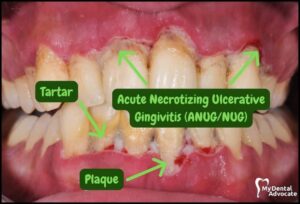What is it?
Necrotizing ulcerative gingivitis (NUG), also known as trench mouth, is a severe form of gingivitis characterized by painful, ulcerative lesions and necrosis (tissue death) of the gingival tissues. It is most commonly associated with bacterial infections, particularly the overgrowth of anaerobic bacteria such as Fusobacterium, Prevotella, and Treponema species, often in the setting of poor oral hygiene and other predisposing factors.
Here are some key points about necrotizing ulcerative gingivitis (NUG):
- Causes and Risk Factors: NUG is typically caused by an imbalance in the oral microbial flora, leading to the overgrowth of pathogenic bacteria and a breakdown of the protective mechanisms of the gingival tissues. Predisposing factors for NUG include poor oral hygiene, smoking, stress, malnutrition, immunosuppression, and systemic conditions such as HIV/AIDS. These factors create an environment conducive to bacterial proliferation and the development of NUG.
- Clinical Presentation: Necrotizing ulcerative gingivitis typically presents with the following signs and symptoms:
- Painful, ulcerative lesions of the gingiva, often with a punched-out appearance and grayish or yellowish pseudomembranes covering the ulcerated areas.
- Spontaneous bleeding from the gums, particularly upon gentle probing or brushing of the teeth.
- Halitosis (bad breath) due to the presence of necrotic tissue and bacterial overgrowth.
- Swollen and tender gingival tissues, often with a fiery red or purplish hue.
- Regional lymphadenopathy (enlarged lymph nodes) in severe cases, indicating systemic involvement.
- Diagnosis: Diagnosis of necrotizing ulcerative gingivitis is based on clinical examination and assessment of the characteristic signs and symptoms. In some cases, laboratory tests such as microbial culture or polymerase chain reaction (PCR) analysis may be performed to identify the causative bacteria and guide treatment decisions. Differential diagnosis may include other forms of gingivitis, periodontitis, or oral mucosal diseases with similar clinical features.
- Treatment: Treatment of necrotizing ulcerative gingivitis aims to control infection, reduce inflammation, and promote healing of the affected gingival tissues. Management options may include:
- Mechanical debridement of necrotic tissue and plaque biofilm from the gingival surfaces, often performed using ultrasonic or hand instruments under local anesthesia.
- Antimicrobial therapy with systemic antibiotics such as metronidazole, amoxicillin/clavulanate, or doxycycline to target the underlying bacterial infection.
- Topical antiseptic mouthwashes or oral rinses containing chlorhexidine or hydrogen peroxide to reduce bacterial load and promote gingival healing.
- Pain management with analgesics or nonsteroidal anti-inflammatory drugs (NSAIDs) to alleviate discomfort and facilitate oral hygiene practices.
- Adjunctive measures such as nutritional counseling, stress reduction techniques, and smoking cessation counseling to address predisposing factors and promote overall oral health.
- Follow-up and Prevention: Patients with necrotizing ulcerative gingivitis should be closely monitored for resolution of symptoms and signs of disease recurrence. Follow-up dental visits may include professional cleaning, oral hygiene instruction, and reinforcement of preventive measures to maintain oral health and prevent recurrence of NUG. Good oral hygiene practices, regular dental check-ups, and avoidance of risk factors such as smoking are essential for the prevention of necrotizing ulcerative gingivitis.
In summary, necrotizing ulcerative gingivitis is a severe form of gingivitis characterized by painful, ulcerative lesions and necrosis of the gingival tissues. It is caused by bacterial infections, often in the setting of poor oral hygiene and other predisposing factors. Prompt diagnosis and appropriate treatment are essential for controlling infection, reducing inflammation, and promoting healing of the affected gingival tissues in individuals with necrotizing ulcerative gingivitis.

